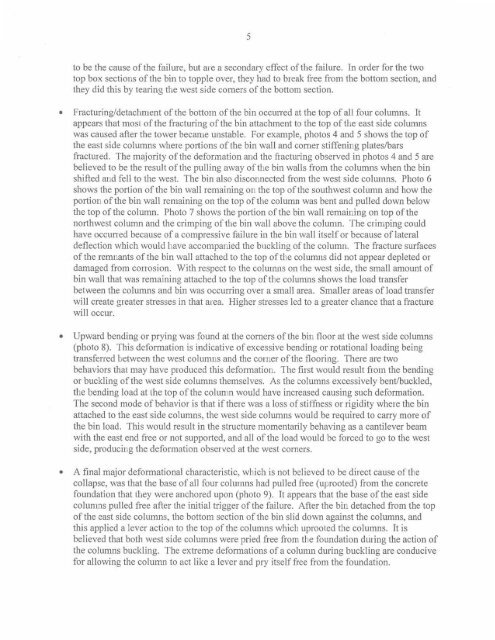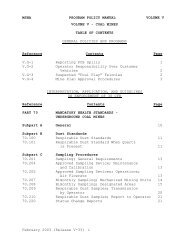Technical Support Report of Surge Bin Tower - Mine Safety and ...
Technical Support Report of Surge Bin Tower - Mine Safety and ...
Technical Support Report of Surge Bin Tower - Mine Safety and ...
You also want an ePaper? Increase the reach of your titles
YUMPU automatically turns print PDFs into web optimized ePapers that Google loves.
5<br />
to be the cause <strong>of</strong> the failure, bUL are a secondary effect <strong>of</strong> the failure. Tn order for the two<br />
top box sections <strong>of</strong> the bin to topple over, they had to break free from the bottom section, <strong>and</strong><br />
they did this by tearing the west side comers <strong>of</strong> the bottom section.<br />
• Fracturing/detachment <strong>of</strong> the bottom <strong>of</strong> the bin occurred at the top <strong>of</strong> all four columns. It<br />
appears that most <strong>of</strong> the fracturing <strong>of</strong> the bin attachment to the top <strong>of</strong> the east side columns<br />
was caused after the tower became unstable. For example, photos 4 <strong>and</strong> 5 shows the top <strong>of</strong><br />
the east side columns where portions <strong>of</strong> the bin wall <strong>and</strong> corner stiffening plateslbars<br />
fractured. The majority <strong>of</strong> the deformation <strong>and</strong> the fracturing observed in photos 4 <strong>and</strong> 5 are<br />
believed to be the result <strong>of</strong> the pulling away <strong>of</strong>the bin walls from the columns when the bin<br />
shifted <strong>and</strong> fell to the west. The bin also disconnected from the west side colmnns. Photo 6<br />
shows the portion <strong>of</strong> the bin wall remaining on the top <strong>of</strong> the southwest column <strong>and</strong> how the<br />
portion <strong>of</strong> the bin wall remaining on the top <strong>of</strong> the column was bent <strong>and</strong> pulled down below<br />
the top <strong>of</strong> the column. Photo 7 shows the portion <strong>of</strong> the bin wall remaining on top <strong>of</strong> the<br />
northwest column <strong>and</strong> the crimping <strong>of</strong> the bin wall above the colunm. The crimping could<br />
have occuned because <strong>of</strong> a compressive failure in the bin wall itself or because <strong>of</strong> lateral<br />
deflection which would have accompanied the buckling <strong>of</strong> the column. The fracture surfaces<br />
<strong>of</strong> the remnants <strong>of</strong> the bin wall attached to the top <strong>of</strong> the columlls did not appear depleted or<br />
damaged from corrosion. With respect to the COIUlrulS on the west side, the small amount <strong>of</strong><br />
bin wall that was remaining attached to the top <strong>of</strong> the columns shows the load transfer<br />
between the columns <strong>and</strong> bin was occurring over a small area. Smaller areas <strong>of</strong>load transfer<br />
will create greater stresses in that area. Higher stresses led to a greater chance that a fracture<br />
will occur.<br />
• Upward bending or prying was fo und at the comers <strong>of</strong> the bin floor at the west side columns<br />
(photo 8). This deformation is indicative <strong>of</strong> excessive bending or rotational loading being<br />
transferred between the west columns <strong>and</strong> the comer <strong>of</strong> the flooring. There are two<br />
behaviors that may have produced this defonnation. The first would result from the bending<br />
or buckling <strong>of</strong> the west side columns themselves. As the columns excessively bentlbuckled,<br />
the bending load at the top <strong>of</strong> the column would have increased causing such deformation.<br />
The second mode <strong>of</strong> behavior is that if there was a loss <strong>of</strong> stiffness or rigidity where the bin<br />
attached to the east side columns, the west side colwnns would be req uired to carry more <strong>of</strong><br />
the bin load. This would result in the structure momentarily behaving as a cantilever beam<br />
with the east end free or not supported, <strong>and</strong> all <strong>of</strong> the load would be forced to go to the west<br />
side, producing the deformation observed at the west comers.<br />
• A final major deformational characteristic, which is not believed to be direct cause <strong>of</strong> the<br />
collapse, was that the base <strong>of</strong> all four columns had pulled free (uprooted) from the concrete<br />
foundation that they were anchored upon (photo 9). It appears that the base <strong>of</strong> the east side<br />
columns pulled free after the initial trigger <strong>of</strong> the failure. After the bin detached from the top<br />
<strong>of</strong> the east side columns, the bottom section <strong>of</strong> the bin slid down against the columns, <strong>and</strong><br />
this applied a lever action to the top <strong>of</strong> the columns which uprooted the columns. It is<br />
believed that both west side columns were pried free from the foundation during the action <strong>of</strong><br />
the columns buckling. The extreme deformations <strong>of</strong> a column during buckling are conducive<br />
for allowing the column to act like a lever <strong>and</strong> pry itself free from the foundation.

















